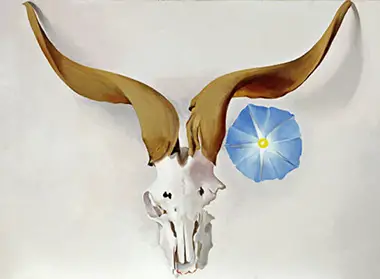The exuberance of a morning glory flower in fresh bloom is juxtaposed against the skull of a ram, motionless but not quite silent in death.
While it may not always be common to find these two together out in nature, it is not impossible or improbable. New life and especially plants, often thrive in the face of death. Flowers bloom, celebrating life, as the roots draw nourishment from decayed corpses of animals that passed that way before. It is no wonder that the artist was inspired to do this painting.
The painting celebrates Georgia O'Keeffe's own transition. It marks the death of one aspect of her life as an artist and a woman and the blooming of even better things. When she moved to New Mexico at a relatively late stage in her life, it could have meant the end of her career. She put a close to the chapter of her life spent in New York City, leaving her husband and all the opportunities he presented behind.
The ram's head in Rams Head Blue Morning Glory is strong, just like the legacy the artist had built. She was, at that time, one of the greatest artists in the country. The move to New Mexico allowed her to produce fresh work.
Beautiful and strong, the morning glory symbolises how much she flourished in the isolation of the desert. Her latter paintings, such as Oriental Poppies and Ram's Head With Hollycock, reflect this as well.
The ram's head is an important part of Hopi culture. It is part of New Mexico's landscape as well. O'Keeffe's focus on this symbol in Rams Head Blue Morning Glory reflects her deep respect for both the land and the culture.
